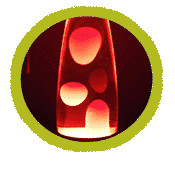SCIENCE EXPERIMENTS FOR KIDS
HOW TO MAKE A LAVA LAMP
Travel back to a bedroom in the 60’s with this groovy lava lamp


Tested, edited & approved by:
Bryan Holmes,
Assistant Director of Education
This animal is not on exhibit in the habitats. It is one of our Animal Ambassadors and is used in public and school programs.
Lava lamps! Who hasn’t spent an eternity mesmerized by those gelatinous blobs slithering through tubes of colored water? Now your kids can make their own lava lamps with common household items and a staple from your bathroom cabinet. Put on some Jimi Hendrix and get to work!
Lava lamps demonstrate liquid density, which is the phenomenon where less dense liquids float atop more dense liquids. This activity is interesting because rising gas bubbles carry big drops of water with them up through the oil, and those drops of water fall down again once the bubble reaches the surface. Kids love watching these lava lamps because of the colorful blobs that are moving around. Even if they have no idea who Jimi Hendrix is.
GATHER THIS:
- Effervescent-antacid-and-pain-relieving tablet (e.g. Alka-Seltzer)
- Vegetable oil
- Water
- Tall clear plastic container (1 or 2 liter bottle)
- Food coloring in various colors or beet juice
THEN DO THIS:
- Fill the bottle about 2/3 full with oil.
- Add food coloring for color. We like about 8 to 10 droplets.
- Fill the rest of the bottle with water, a few inches below the brim.
- Add a half or quarter of an antacid tablet, e.g. Alka-Seltzer tablet to the bottle.
WHAT IS HAPPENING?
Notice the oil floats on top of the colored water. Oil floats on the water because it is less dense than water. The two do not mix because water is composed of polar molecules and oil is composed of nonpolar molecules. When the antacid tablet is dropped into the container of oil and water, the tablet sinks because it is more dense than the oil or the water. Once the tablet hits the water, it begins to dissolve and the chemicals in the tablet react with each other creating bubbles of carbon dioxide gas.
When enough gas enters an area of water, the water and gas combination in this spot becomes less dense than the water around it, so it floats up through the water. If this water-and-gas mixture is less dense than the oil, it floats up through the oil too. The water is attracted to itself and not to the oil, this causes the water-and-gas mixture to move through the oil in a ball-shape.
Once a ball of water and gas gets to the surface, some bubbles of carbon dioxide gas pop, releasing the gas into the air. When enough bubbles pop, the water and remaining gas becomes denser than the oil. The ball of water sinks through the oil and joins the water. Changes in density as gas is added or escapes from water causes it to float up and sink down through the oil creating the lava lamp effect.
WHAT THIS TEACHES:
Skills: Observation
Themes: Chemistry, gas, surface tension
Experiment credit: Contributed by the Chi Epsilon Mu (XEM) Chemistry Club at Austin State University
Join the CuriOdyssey Community
LOCATION
1651 Coyote Point Drive
San Mateo, CA 94401
Ohlone Land Acknowledgement
650-342-7755
[email protected]
CuriOdyssey is a 501(c)(3) nonprofit, Tax ID 94-1262434


